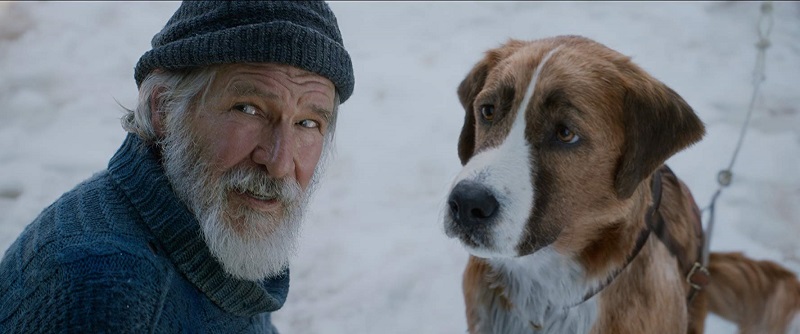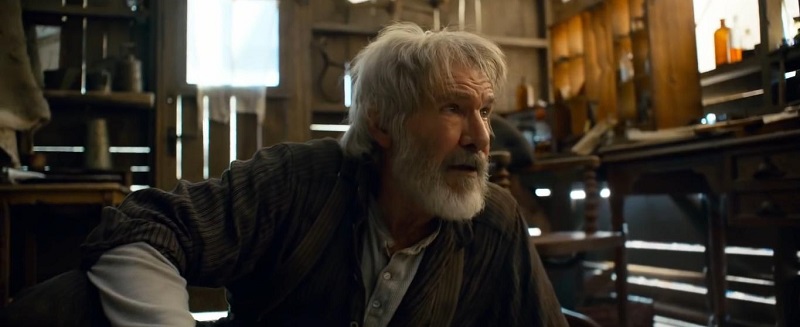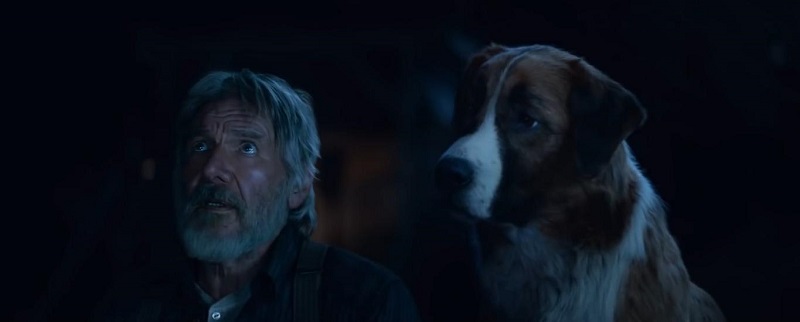One of the first books I truly remember reading on my own was Jack London’s seminal classic, The Call of the Wild. It tattooed my soul with its sweeping epic feel and simultaneous intimate tale of our species’ best friend. Buck, the main character, had a journey worthy of the author’s gift of landscape descriptors that paint a picture of the Yukon wilds of Canada that left me gasping with a youthful verve of wanderlust dreams.

Bringing the famed writer’s beloved Wild story to the screen in a visually realistic manner has sadly taken quite some time. There was a 1923 silent movie adaptation, produced by famed Hal Roach. Then, there was the 1935 incarnation starring Clark Gable while 1972 saw Charlton Heston tackle the grizzled John Thornton character and lastly, there was the forgettable 1976 television flick.
In 2020, we are gifted a role that seems to have been custom written for Harrison Ford. His John Thornton finds himself “lost” in the Yukon. He’s not there in search of gold by any means. He has ventured to what feels like the frozen end of the earth seeking a tonic for his deep emotional scars caused by the tragic death of his son. When he meets Buck, it becomes clear that each was on a fateful path to run into the other. The imprint each has on the other is indelible and not necessarily immediate.
London makes you earn that emotive expression over a time of tale telling that makes it even more rich, endearing and lasting. Even in this blink and it’s gone pop culture society, this is a story that not only has transcended the passage of time (it’s moved into its second century), but does so in a manner that will spur its audience to treasure that finite entity that is life.
With Ford anchoring and narrating The Call of the Wild, he sets a tone with the telling of Buck’s life from the get-go.
The key to the entire endeavor of London’s beloved story is the existence of the dog itself. Previous film versions did their best with live dogs and trainers that worked overtime to achieve somewhat of the reality that was born from the author’s pages. Thanks to advancements in CGI, we have realistic creature creations. Finally, filmmakers can craft a canine onscreen and have it produce everything that they can conceivably dream of within the lexicon of this story. To get to the heart of the impeccable literary painting that London was artistically achieving on his pages, it was a wise decision to go with a CG dog instead of trying to train a team of Bucks to do the same thing.
When the first The Call of the Wild trailer premiered, some writers in the film community wrote that the dog looked a bit “off.” Of course, the thing about analyzing special effects in a trailer is oftentimes the work isn’t complete. Other times what we witness is being seen out of context. The eye and mind connection is a powerful thing. Once the film gets going, viewers will discover that we are utterly engrossed by Buck—regardless of initial impressions of the “realness” of London’s canine creation.
London’s novel was published in 1903, just over a decade from when it was set to take place (during the 1890s Klondike gold rush that saw tens of thousands of souls with a dream traversing the rough, rugged and unflinching wilderness that all too many were not prepared for enduring). The lure of riches got many souls to undertake the treacherous journey into the unrelenting elements of that part of the planet. What I adore most about this London-penned tale is how the rush of people to Alaska and points north with dollar-signs in their eyes is merely the background—the landscape if you will—for the heart of the writer’s true narrative. He then zeroes in on the emotions that accompany canine-human history and exponentially grows the emotive breadth as Buck’s life path extends.

Ford is terrific and although it may have seemed tempting to portray Thornton as a grizzled, hope-scorned soul, he grounds his character in the realism that was men of that period of history. Yes, he is hurting, and he wears that pain on his sleeve. But within the confines of Alaska and the Yukon, he is surviving…living day-to-day and doing his best to keep his son’s memory alive simply through the pain of living without him. The superstar delivers one of his more centered turns and it is easy to see that the story spoke to him.
The Call of the Wild has a pretty substantial supporting cast and each rises to the occasion that is the beloved novel getting the screen version it deserved. Karen Gillan (Guardians of the Galaxy, Jumanji), Omar Sy (The Intouchables), Bradley Whitford (Get Out), Dan Stevens (Beauty and the Beast) and Cara Gee (The Expanse) make the most of their screen time and embody that old Hollywood phrase that “there are no small parts, only small actors.”
Director Chris Sanders (Lilo & Stitch, How to Train Your Dragon and The Croods) makes the leap to live action seamlessly. His command of story stems from his years of writing them, such as Mulan. He gets the most from Ford, who is no stranger to acting opposite things that aren’t there, and his ensemble. They all seem to realize that this is a beloved book that has endeared itself to generation after generation. If The Call of the Wild is a novel that speaks to you, or if you are simply drawn to stories about the priceless connection between human and canine, Sanders has delivered a cinematic experience that pushes all the right emotive buttons.

If there is any drawback to the story, it is that it takes a little while to get going. Once we arrive in the Yukon and Thornton and his furry BFF take flight, the experience becomes the cinema’s version of a page turner.
Grade: B+

